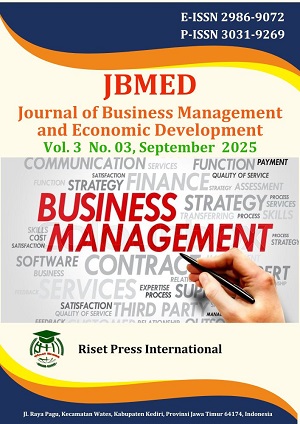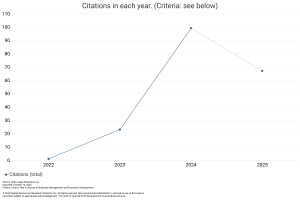Digital Currency Adoption and Its Impact on Monetary Policy Effectiveness in Emerging Markets: A Comparative Analysis
DOI:
https://doi.org/10.59653/jbmed.v3i03.1940Keywords:
Digital currency, monetary policy, emerging markets, cryptocurrency, financial innovation, policy transmission, comparative analysisAbstract
This study examines the relationship between digital currency adoption and monetary policy effectiveness across emerging markets through a comprehensive comparative analysis of twelve countries over the period 2018-2024. Using panel data regression analysis and a mixed-methods approach, we investigate how the proliferation of digital currencies—including cryptocurrencies and central bank digital currencies (CBDCs)—affects traditional monetary policy transmission mechanisms. Our findings reveal significant heterogeneity in the impact of digital currency adoption on monetary policy effectiveness, with countries exhibiting varying degrees of policy transmission disruption. The results indicate that higher levels of digital currency adoption are associated with reduced effectiveness of conventional interest rate policies, particularly in countries with weaker institutional frameworks. However, nations implementing CBDCs demonstrate improved monetary policy transmission compared to those with predominantly decentralized cryptocurrency adoption. The study contributes to the emerging literature on digital finance and monetary policy by providing empirical evidence of the trade-offs between financial innovation and monetary policy autonomy in developing economies. These findings have significant implications for central banks in emerging markets as they navigate the digital transformation of their financial systems while maintaining monetary stability.
Downloads
References
Adrian, T., & Mancini-Griffoli, T. (2019). The rise of digital money. IMF Fintech Notes, 19/01.
Armelius, H., Boel, P., Claussen, C. A., & Nessén, M. (2021). The e-krona and the macroeconomy. Sveriges Riksbank Economic Review, 2018(3), 43-65.
Auer, R., & Böhme, R. (2020). The technology of retail central bank digital currency. BIS Quarterly Review, March, 85-100.
Barrdear, J., & Kumhof, M. (2016). The macroeconomics of central bank issued digital currencies. Bank of England Working Paper, 605.
Bernanke, B. S., & Gertler, M. (1995). Inside the black box: the credit channel of monetary policy transmission. Journal of Economic Perspectives, 9(4), 27-48.
Boar, C., Holden, H., & Wadsworth, A. (2020). Impending arrival–a sequel to the survey on central bank digital currency. BIS Papers, 107.
Bretas, V. P. G., & Alon, I. (2021). Franchising research on emerging markets: Bibliometric and content analyses. Journal of Business Research, 133. https://doi.org/10.1016/j.jbusres.2021.04.067
Brunnermeier, M. K., James, H., & Landau, J. P. (2019). The digitalization of money. NBER Working Paper, 26300.
Cecchetti, S. G., Krause, S., & Moessner, R. (2002). Assessing the sources of changes in the volatility of real and nominal exchange rates. BIS Working Papers, 115.
Dana, L. P., Salamzadeh, A., Mortazavi, S., & Hadizadeh, M. (2022). Investigating the Impact of International Markets and New Digital Technologies on Business Innovation in Emerging Markets. Sustainability (Switzerland), 14(2). https://doi.org/10.3390/su14020983
Fernández-Villaverde, J., Sanches, D., Schilling, L., & Uhlig, H. (2021). Central bank digital currency: Central banking for all? Review of Economic Dynamics, 41, 225-242.
Huang, Y., Luk, P., & Smith, R. T. (2022). Central bank digital currency and monetary policy transmission: A theoretical analysis. Economic Modelling, 107, 105715.
Khai Nguyen, Q., & Cuong Dang, V. (2022). The effect of FinTech development on financial stability in an emerging market: The role of market discipline. Research in Globalization, 5. https://doi.org/10.1016/j.resglo.2022.100105
Kumar, V., & Srivastava, R. (2020). New perspectives on business model innovations in emerging markets. In Journal of the Academy of Marketing Science (Vol. 48, Issue 5). https://doi.org/10.1007/s11747-019-00713-2
Kumari, V., Bala, P. K., & Chakraborty, S. (2023). An Empirical Study of User Adoption of Cryptocurrency Using Blockchain Technology: Analysing Role of Success Factors like Technology Awareness and Financial Literacy. Journal of Theoretical and Applied Electronic Commerce Research, 18(3). https://doi.org/10.3390/jtaer18030080
Luu, H. N., Do, D. D., Pham, T., Ho, V. X., & Dinh, Q. A. (2023). Cultural values and the adoption of central bank digital currency. Applied Economics Letters, 30(15). https://doi.org/10.1080/13504851.2022.2089342
Maryaningsih, N., Nazara, S., Kacaribu, F. N., & Juhro, S. M. (2022). CENTRAL BANK DIGITAL CURRENCY: WHAT FACTORS DETERMINE ITS ADOPTION? Buletin Ekonomi Moneter Dan Perbankan/Monetary and Banking Economics Bulletin, 25(1). https://doi.org/10.21098/bemp.v25i1.1979
Mishkin, F. S. (1995). Symposium on the monetary transmission mechanism. Journal of Economic Perspectives, 9(4), 3-10.
Mishra, P., Montiel, P. J., & Spilimbergo, A. (2012). Monetary transmission in low-income countries: Effectiveness and policy implications. IMF Economic Review, 60(2), 270-302.
Montoro, C., & Moreno, R. (2011). The use of reserve requirements as a policy instrument in Latin America. BIS Quarterly Review, March, 53-65.
Mohammed, M. A., De-Pablos-Heredero, C., & Montes Botella, J. L. (2023). Exploring the Factors Affecting Countries’ Adoption of Blockchain-Enabled Central Bank Digital Currencies. Future Internet, 15(10). https://doi.org/10.3390/fi15100321
Ozili, P. K. (2022). Central bank digital currency research around the world: a review of literature. Journal of Money Laundering Control, 25(2), 215-229.
Petry, J., Koddenbrock, K., & Nölke, A. (2023). State capitalism and capital markets: Comparing securities exchanges in emerging markets. Environment and Planning A, 55(1). https://doi.org/10.1177/0308518X211047599
Ronaghi, M. H. (2023). A contextualized study of blockchain technology adoption as a digital currency platform under sanctions. Management Decision, 61(5). https://doi.org/10.1108/MD-03-2022-0392
Roussou, I., Stiakakis, E., & Sifaleras, A. (2019). An empirical study on the commercial adoption of digital currencies. Information Systems and E-Business Management, 17(2–4). https://doi.org/10.1007/s10257-019-00426-7
Sahasranamam, S., Arya, B., & Sud, M. (2020). Ownership structure and corporate social responsibility in an emerging market. Asia Pacific Journal of Management, 37(4). https://doi.org/10.1007/s10490-019-09649-1
Salisu, A. A., Sikiru, A. A., & Vo, X. V. (2020). Pandemics and the emerging stock markets. Borsa Istanbul Review, 20. https://doi.org/10.1016/j.bir.2020.11.004
Samiee, S., & Chirapanda, S. (2019). International Marketing Strategy in Emerging-Market Exporting Firms. Journal of International Marketing, 27(1). https://doi.org/10.1177/1069031X18812731
Solberg Söilen, K., & Benhayoun, L. (2022). Household acceptance of central bank digital currency: the role of institutional trust. International Journal of Bank Marketing, 40(1). https://doi.org/10.1108/IJBM-04-2021-0156
Tannoury, M., & Attieh, Z. (2017). The Influence of Emerging Markets on the Pharmaceutical Industry. In Current Therapeutic Research - Clinical and Experimental (Vol. 86). https://doi.org/10.1016/j.curtheres.2017.04.005
Xia, H., Gao, Y., & Zhang, J. Z. (2023). Understanding the adoption context of China’s digital currency electronic payment. Financial Innovation, 9(1). https://doi.org/10.1186/s40854-023-00467-5
Yermack, D. (2015). Is Bitcoin a real currency? An economic appraisal. Handbook of Digital Currency, 31-43.
Yüksel, S., & Canöz, İ. (2017). Does Bitcoin affect the monetary policy transmission mechanism in Turkey? European Journal of Social Sciences, 1(2), 31-38.
Downloads
Published
How to Cite
Issue
Section
License
Copyright (c) 2025 Citrawati Jatiningrum, Hardini Ariningrum, Satria Abadi, Abshor Marantika

This work is licensed under a Creative Commons Attribution-ShareAlike 4.0 International License.
Authors who publish with this journal agree to the following terms:
- Authors retain copyright and grant the journal right of first publication with the work simultaneously licensed under a Creative Commons Attribution-ShareAlike that allows others to share the work with an acknowledgement of the work's authorship and initial publication in this journal.
- Authors are able to enter into separate, additional contractual arrangements for the non-exclusive distribution of the journal's published version of the work (e.g., post it to an institutional repository or publish it in a book), with an acknowledgement of its initial publication in this journal.
- Authors are permitted and encouraged to post their work online (e.g., in institutional repositories or on their website) prior to and during the submission process, as it can lead to productive exchanges, as well as earlier and greater citation of published work (See The Effect of Open Access).





























